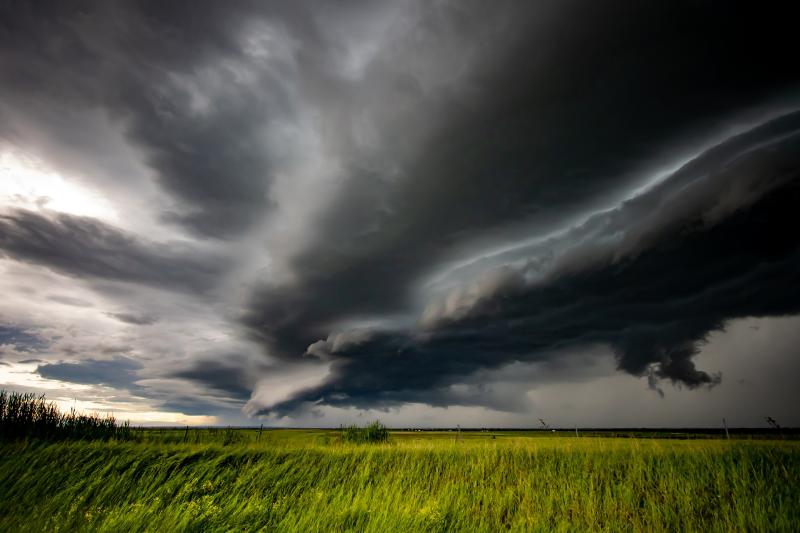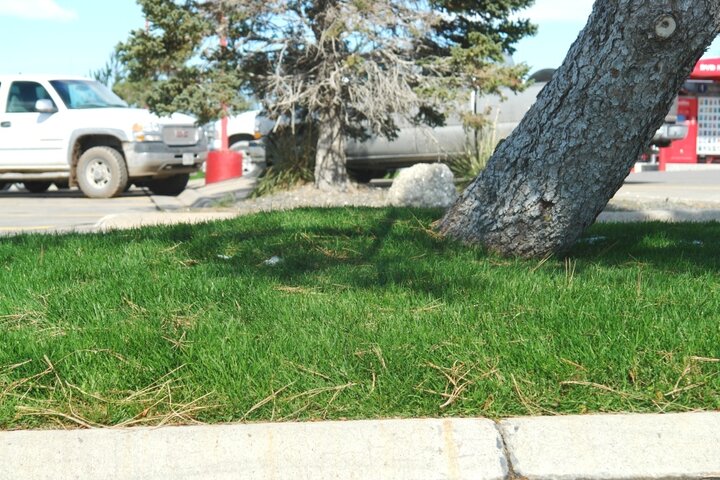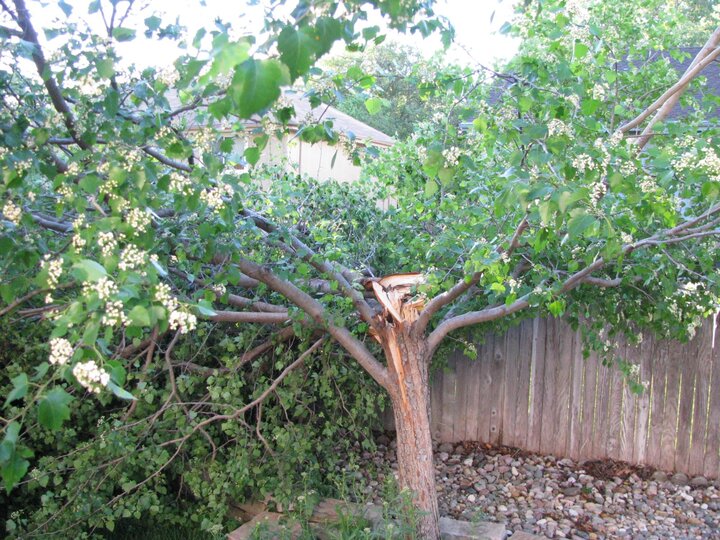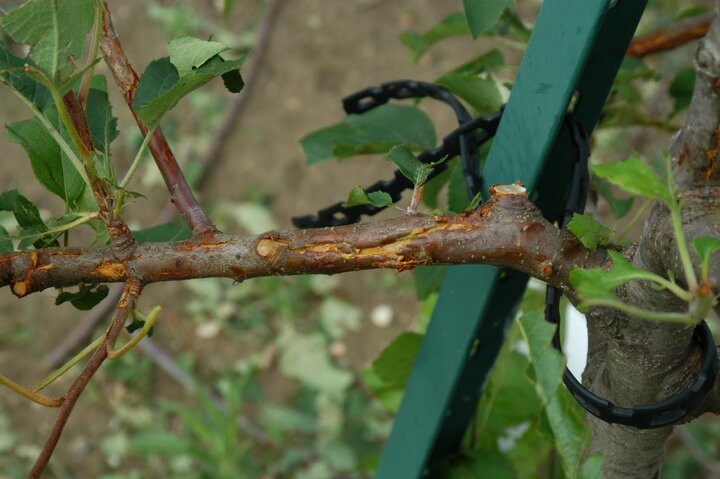Sarah Browning, Nebraska Extension Educator

Nebraskans have seen their share of severe weather in recent weeks and as a result many landscape plants have been damaged by high winds and hail. Pixabay.com
Nebraskans have seen their share of severe weather in recent weeks and as a result many landscape plants have been damaged by high winds and hail.

Wind Damage
Straight-line winds have uprooted some trees completely and pushed some trees over at an angle, breaking a portion of the roots on the windward side of the tree. Trees leaning from root breakage usually do not survive. In some cases, trees were susceptible to wind damage because of previously damaged or poorly developed root systems. If a leaning tree does survive, it often becomes a hazard due to potential damage if it fell.
Mature trees rarely survive attempts to pull them back into place. Generally, these trees should be removed and replaced.
Very young trees, planted less than four years, may survive if they are gently pulled back into a vertical position and staked. Avoid additional damage to the remaining roots and GENTLY press out any air spaces that may have formed in the loosened soil. Water as needed to maintain tree health and vigor for the next few years. But realize the leaning tree very likely had underlying root problems which made it susceptible to wind damage in the first place, so it’s probably better to figure out what the root problem where, then remove and replace it with a well-planted healthy tree.

Pruning Damaged Branches
Twisted and broken tree branches are another aspect of storm damage. Safety is the first consideration in removing branches from storm-damaged trees and a certified arborist should be contacted to remove large branches or to work in tall trees.
All loose or hanging branches should be removed as soon as possible. Branches that are cracked, split or twisted should be removed next. Branch stubs left by storm damaged should be given a clean cut, using good techniques so stubs are eliminated but only branch wood is removed. This results in a smaller wound, allows the tree to seal the wound more effectively and minimizes the chance of wood decay fungi entry into the trunk.
Trees split down the middle are very difficult to brace adequately and should be removed by a professional arborist.

Hail Damage
Minor hail damage, such as holes in the leaves of hosta or slight defoliation of trees and shrubs, has also occurred. In most cases, nothing needs to be done by the gardener except to provide good basic care for the remainder of the growing season including deep infrequent irrigation when summer conditions turn dry.
Major damage includes 1) stripping of 50% or more of plant foliage, 2) pocks or tears in tree bark with damage to the underlying xylem and phloem tissues, 3) shearing of evergreen buds from branch terminals, 4) death of evergreen buds due to impact damage, and 5) broken tree or shrub branches.

Damage to a tree’s vascular system limits its’ ability to move water up from the roots and into the secondary branches and leaves. Movement of nutrients throughout the tree is also reduced. Over the next few years, previously healthy vigorous trees will produce callus tissue to seal off bark wounds and re-establish vascular function. Until then, they have a reduced ability to move water and cope with dry conditions, which in Nebraska are often exacerbated by high winds that accelerate water loss from leaves.
In most cases, homeowners should take a “wait and see” attitude. Trees and shrubs should be kept well-watered throughout summer and fall to avoid drought stress. Winter watering during warm periods when soil is not frozen is also recommended if winter conditions are dry. Keep plants well mulched to prevent secondary injury from mowers and string trimmers.
Evergreens. Secondary pests, such as borers and aphids, should be controlled to avoid additional stresses. Sphaeropsis tip blight can be a serious problem in Austrian and Ponderosa pine trees the year following serious hail injury. Fungicide applications should be planned for next spring to keep infection to a minimum.
Do not automatically fertilize trees and shrubs to "help them recover." Fertilizer may not be needed and can be detrimental by forcing the tree to produce fast-growing lush foliage, at the expense of other recovery efforts such as root growth or wound closure. If the tree is growing in a lawn which is fertilized during the summer, then it’s getting plenty of fertilizer already.
Fruit trees. Copper fungicide applied to damaged fruit trees will help protect wounds from infections by common pathogens like brown rot, bacterial canker, bacterial spot, and fire blight. However, these applications must be made immediately after the storm; wounded tissues have died and dried out by 24-48 hours after the storm and are no longer susceptible to infection. Fungicides applied at this point are not helpful.
Never apply a wound dressing or pruning paint to any wounds, including hail wounds as these products can interfere with the trees own response to closing the wound.
Do not wrap the tree trunk or branches, as this create a hidden area where insects can cause damage without being seen.
Perennials. For hostas and other perennials which suffered severe hail damage, its best to remove the leaf debris with broken stems but allow the remaining foliage with intact stems to stay even though it is ragged and tattered. When new growth begins to appear, the tattered leaves can gradually be removed.
Removing all of a plant’s foliage at once by cutting it back to the ground will ultimately reduce plant vigor. The plant will be forced to use stored energy reserves to regrow new leaves without the benefit of any photosynthetic foliage to aid the regrowth.
More information
- Immediate Care for Storm-Damaged Trees, Nebraska Forest Service
- Caring for Storm-Damaged Trees, Colorado State Forest Service
- How should fruit growers respond to hail and severe storms?
- Hostas, University of Minnesota Extension.
Images
- The shifting of a tree's root plate due to root damage by high winds can be seen as a new hump or bulge in the soil on the windward side of the tree. Image from Eric Berg, former Community Forester with the Nebraska Forest Service.
- Several ornamental pear cultivars, like this young Bradford pear, are prone to wind damage due to their natural branch structure. This tree suffered extreme wind damage and is not salvageable. Image used with permission from a client.
- Hail damage to the leaves of perennials and vegetable crops, like this watermelon, causes sharp tears or holes in the leaves. Image by Gerald Holmes, Strawberry Center, Cal Poly San Luis Obispo, Bugwood.org.
- Hail stones cause pocks or tears in tree bark which damage or kill the underlying xylem and phloem tissues. Image from Sarah Browning, Nebraska Extension